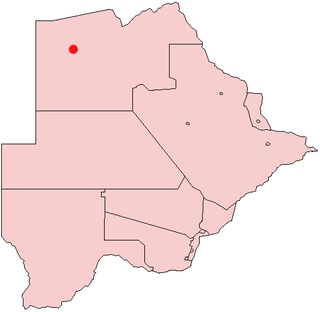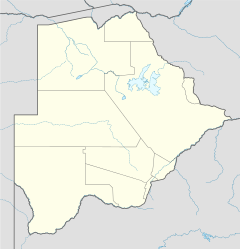
The Okavango Delta in Botswana is a vast inland delta formed where the Okavango River reaches a tectonic trough at an altitude of 930–1,000 m in the central part of the endorheic basin of the Kalahari.

Maun is the fifth-largest town in Botswana. As of 2011, it had a population of 55,784. Maun is the "tourism capital" of Botswana and the administrative centre of Ngamiland district. Francistown and Maun are linked by the A3 highway. Maun is also the headquarters of numerous safari and air-charter operations who run trips into the Okavango Delta.

Palapye is a growing town in Botswana, situated about halfway between Francistown and Gaborone. Over the years its position has made it a convenient stopover on one of Southern Africa's principal north–south rail and road routes.
Tubu is a village in North-West District of Botswana, 10 kilometers due east of Gumare village. It is located close to the Okavango Delta, it has a primary school, a clinic and electricity. The population was 392 in 2001 census.

Ghanzi is a town in the middle of the Kalahari Desert the western part of the Republic of Botswana in southern Africa. The region is the country's pride in contributing a large portion towards the beef industry. In fact, Ghanzi farmers provide about 75% percent of beef exports, according to the Botswana Meat Commission, primarily to the United Kingdom and the European Union.

The North-West District or Ngamiland is one of the first-level administrative subdivisions of Botswana. For census and administrative purposes Ngamiland is subdivided into Ngamiland East, Ngamiland West and Ngamiland Delta (Okavango). It is governed by a District Commissioner, appointed by the national government, and the elected North-West District Council. The administrative centre is Maun.
Bobonong is a town in the Central District of Botswana 80 km from Selibe Phikwe town. Bobonong has a population of around 19,000. The Babirwa tribe can be found in this town. The Botswana Pink semi-precious stones can be found in Bobonong region. The Babirwa are known for harvesting the mophane worm. The locals refer to the town as Bobcity or formerly Lekgarapeng, which was derived from the stoney landscape of the town.

Gumare or Gomare is a rural village located in the North-West District of Botswana, near the Okavango Delta. The population of Gumare was 6,067 in 2001 census, but had risen to 8,532 iby the 2011 census.

Kasane is a town in Botswana, close to Africa's 'Four Corners', where the borders of Botswana, Namibia, Zambia and Zimbabwe almost meet. The town is at the far northeastern corner of Botswana where it serves as the administrative center of the Chobe District. The population of Kasane was 9,244 at the 2011 census.

Moremi Game Reserve is a protected area in Botswana. It lies on the eastern side of the Okavango Delta and was named after Chief Moremi of the BaTawana tribe. Moremi was designated as a game reserve, rather than a national park, when it was created. This designation meant that the BaSarwa or Bushmen that lived there were allowed to stay in the reserve.
Sankuyo is a small village in North-West District of Botswana. It is located close to Okavango Delta, and it has a primary school. The population of the village was 372 in 2001 census. It is also the name of an organisation that runs several lodges in the okavango-delta. One of these lodges is Santawani.

Shakawe is a village located in the northwest corner of Botswana at the beginning of the Okavango Delta, close to Namibia and Angola. Shakawe is awakening from its former status as a sleepy little outpost on the Okavango. For travellers, Shakawe means a Botswana entry or exit stamp or a staging post for a visit to the Tsodilo Hills, 40 km away. For Southern African holiday-makers, it is most often the start of a fishing trip in the Okavango Panhandle. It also provides access to the Caprivi Strip. The record high temperature ever registered in Shakawe was 39.6 °C (103.3 °F). The lowest temperature registered in Shakawe was −6.1 °C (21.0 °F).
Nokaneng is a village in North-West District, Botswana. It is located close to the Okavango Delta, and is served by Nokaneng Airport. The population of Nokaneng was 1,590 in 2001 census.
Seronga is a village in North-West District, Botswana. It is located close to beginning of the Okavango Delta, and has a local airstrip. The population of Seronga was 1,641 in 2001 census. In 2011 population census, the village had a population of 3716 making it the fourth largest village in Ngamiland West. Seronga village has two government schools namely; Seronga Primary School and Ngambao Junior Secondary School. In addition, Seronga village has other government facilities namely Seronga Sub-Land Board, Seronga Police Station, Seronga Airfield, National Parks and Wildlife Office, Tribal Administration office headed by Senior Chief Representative, 24 hour Clinic with a Doctor.
Beetsha is a village in North-West District of Botswana. It is located north of the Okavango River and close to Okavango Delta. The population was 760 in 2001 census.
Ikoga is a village in North-West District of Botswana. It is located close to Okavango Delta and has a primary school. The population was 699 in 2001 census.
Kareng is a village in North-West District of Botswana. It is located close to Okavango Delta, and has a primary school. The population was 599 in 2001 census.
Bodibeng is a village in North-West District of Botswana. It is located in the southern part of the district, close to the Okavango Delta and Lake Ngami, and has a primary school. The population was 472 in 2001 census. It is located in Ngamiland.
Dekar, alternatively D'kar, is a village in Ghanzi District of Botswana. It is located 40 km to the east of the district capital, Ghanzi. The population was 943 in the 2001 census. It was a farm of the Gereformeerde Church, but later evolved into a rural village after being donated to the Naro. The village is governed by the Dutch Reformed Church, which is made up of San leaders in Dekar. A tar road runs 1 km from it, but there is no tar road in the village itself, only a gravel road. This small village also houses Kuru, a San initiative. It has a shop where handcrafted San articles can be bought. The money is then used to help the Kalahari people. Dekar also houses a school and a clinic. About 15 to 20 km outside Dekar there is a game farm on the road to Ghanzi.

The people of the country called Botswana are all referred to as Batswana(pl)/ Motswana(s) in reference to the country name or the land they all hail from, that is regardless of ethnicity, language, skin colour or heritage.










